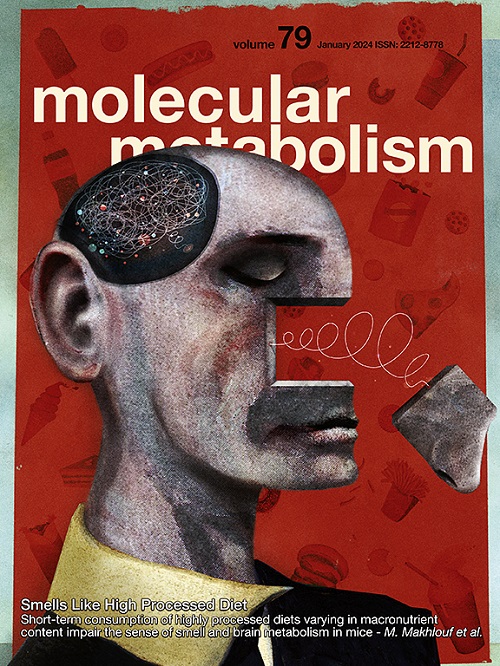双亮氨酸拉链激酶DLK是细胞自主调节胰岛素敏感性所必需的。
IF 6.6
2区 医学
Q1 ENDOCRINOLOGY & METABOLISM
引用次数: 0
摘要
代谢综合征和胰岛素抵抗在一定程度上是由通过c-Jun n -末端激酶(JNK)途径的信号失调驱动的。支架蛋白JIP1及其上游激酶DLK(双亮氨酸拉链激酶)形成一个动态信号复合物,调节JNK的活性,但DLK在葡萄糖代谢中的生理作用尚不清楚。在这里,我们通过三种转基因小鼠模型确定DLK是胰岛素敏感性的关键调节因子:一种是半形DLK等位基因,一种是他莫昔芬诱导的全身DLK敲除,一种是高脂肪饮食诱导的DLK消融肥胖模型。所有模型均表现出与肥胖无关的胰岛素敏感性增强,其特征是肌肉和脂肪组织中葡萄糖摄取增加,并且在高胰岛素-正血糖钳夹研究中改善了对肝脏葡萄糖产生的抑制。在机制上,我们证明DLK以细胞自主的方式发挥作用,通过调节胰岛素刺激下游的AKT和IRS1磷酸化来限制胰岛素信号传导。在培养的成肌细胞和成纤维细胞中,JNK激活和随后的胰岛素信号抑制需要DLK。这些发现表明DLK是全身胰岛素敏感性的调节因子,通过JIP-JNK信号模块独立于肥胖。结果表明,靶向DLK可能是一种改善代谢性疾病胰岛素敏感性的治疗策略。本文章由计算机程序翻译,如有差异,请以英文原文为准。
Dual leucine zipper-bearing kinase DLK is necessary for cell autonomous regulation of insulin sensitivity
Metabolic syndrome and insulin resistance are driven in part by dysregulated signaling through the c-Jun N-terminal kinase (JNK) pathway. The scaffold protein JIP1 and its upstream kinase DLK (dual leucine zipper kinase) form a dynamic signaling complex that modulates JNK activity, yet the physiological role of DLK in glucose metabolism remains undefined. Here, we identify DLK as a critical regulator of insulin sensitivity using three genetically modified mouse models: a hypomorphic DLK allele, a tamoxifen-inducible whole-body DLK knockout, and a high-fat diet–induced obese model with DLK ablation. All models exhibited enhanced insulin sensitivity independent of adiposity, characterized by increased glucose uptake in muscle and adipose tissue, and improved suppression of hepatic glucose production during hyperinsulinemic-euglycemic clamp studies. Mechanistically, we demonstrate that DLK functions in a cell-autonomous manner, limiting insulin signaling through modulation of AKT and IRS1 phosphorylation downstream of insulin stimulation. In cultured myoblasts and fibroblasts, DLK was required for JNK activation and subsequent dampening of insulin signaling. These findings establish DLK as a regulator of whole-body insulin sensitivity, independent of obesity through a JIP-JNK signaling module. The results suggest that targeting DLK could represent a therapeutic strategy for improving insulin sensitivity in metabolic disease.
求助全文
通过发布文献求助,成功后即可免费获取论文全文。
去求助
来源期刊

Molecular Metabolism
ENDOCRINOLOGY & METABOLISM-
CiteScore
14.50
自引率
2.50%
发文量
219
审稿时长
43 days
期刊介绍:
Molecular Metabolism is a leading journal dedicated to sharing groundbreaking discoveries in the field of energy homeostasis and the underlying factors of metabolic disorders. These disorders include obesity, diabetes, cardiovascular disease, and cancer. Our journal focuses on publishing research driven by hypotheses and conducted to the highest standards, aiming to provide a mechanistic understanding of energy homeostasis-related behavior, physiology, and dysfunction.
We promote interdisciplinary science, covering a broad range of approaches from molecules to humans throughout the lifespan. Our goal is to contribute to transformative research in metabolism, which has the potential to revolutionize the field. By enabling progress in the prognosis, prevention, and ultimately the cure of metabolic disorders and their long-term complications, our journal seeks to better the future of health and well-being.
 求助内容:
求助内容: 应助结果提醒方式:
应助结果提醒方式:


